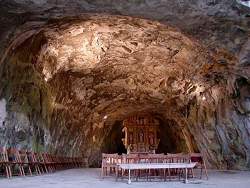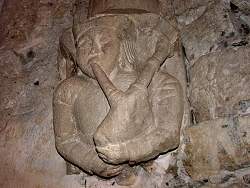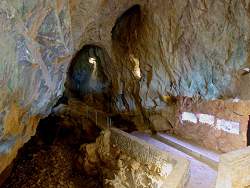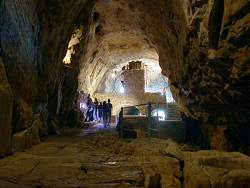San Giovanni d’Antro
Landarska Jama
Useful Information


| Location: |
Friuli Venezia Giulia.
Near Cividale, between Pulfero and San Pietro al Natisone.
From Udine follow road 54 to the northeast along the river Natisone.
(46.151596, 13.474215) |
| Open: |
JAN Sun, Hol 10:30-16. APR to JUL Sun, Hol 10:30-18. AUG daily 10:30-18. SEP to DEC Sun, Hol 10:30-18. Closed on Easter weekend. [2021] |
| Fee: |
Adults EUR 7, Children (6-12) EUR 5, Children (0-5) free, Seniors (65+) EUR 5, Disabled EUR 5. Groups (15+): Adults EUR 5. [2021] |
| Classification: |
 Karst Cave Karst Cave
 Cave Church Cave Church
|
| Light: |
 Incandescent Incandescent
|
| Dimension: | L=5,400 m, A=348 m asl, T=11 °C. |
| Guided tours: | D=60 min, L=300 m. |
| Photography: | allowed |
| Accessibility: | no |
| Bibliography: |
Giuseppe Muscio, Umberto Sello (1981):
Le Grotte di S. Giovanni d’Antro,
Speleologia 5, 1981, S. 12ff.
Speleologia n. 5 - giugno 1981
|
| Address: |
Gruppo Speleologico Valli del Natisone, Via Antro, San Giovanni d’Antro, 33046 Pulfero (UD), Tel: +39-339-7779367.
E-mail: |
| As far as we know this information was accurate when it was published (see years in brackets), but may have changed since then. Please check rates and details directly with the companies in question if you need more recent info. |
|
History
| 9th century | the cave was used as a sanctuary. |
| 1001 | stone staircase errected. |
| 1477 | Gothic-Carinthian apse built by architect Andrea di Lack. |
| 1885 | first unsuccessful attempt to cross the cave lake. |
| 1893-1898 | exploration by Achille Telli, a pioneer of Friulian speleology. |
| 1906 | first attempt to develop it as a show cave by Alfredo Lazzarini. |
| 1968 | the paths and the light were repaired. |
| DEC-1974 | new discoveries by the C.S.I.F. from Udine. |
| 1975 | further discoveries. |
Description






The Grotte San Giovanni d’Antro is a small show cave located in the southern pre-Alps. The cave system has a cave river which flows during winter rains and sometimes after heavy rains. The entrance was used to construct a cave church inside, with a church built in front of the entrance, and the huge entrance chamber remodelled as a cave church. The valley leads towards the Julian Alps, which belong to Slovenia. The Slovenian border is right at the end of the valley and more than 80% of the population are Slovenes, so the cave also has an Slowenian name which is Landarska Jama.
This cave is both at the same time: secluded and in a prominent location, visible from far away. When driving up Natisone valley from Udine towards Slovenia, a nice, fertile and wide valley, you once reach the southern outskirts of the Alps, the Julian Alps. The valley becomes deeper, with steep limestone cliffs on the northern side. The cave church of San Giovanni d’Antro at the foot of the cliff and visible from the valley below. Turning off the main road to the left, a well paved but extremely steep road leads up to the small village Antro, which belongs to Cividale. At the upper end of the village, behind the church is a small parking lot with a sign about the cave. A paved path leads along the mountain side to a river bed at the foot of a cliff. Explanatory signs along the path tell much about the area, the geology, biology and history of this place.
At the foot of the limestone cliff a steep staircase with 86 steps leads up the cave church. Entering the massive wooden door, the visitor is in the basement of the church. There is a huge water tunnel crossing the building, the bed of the cave river, which is dry during summer. It leaves the building through a huge portal in the massive wall and forms a steep ravine below. Going up the stone steps we reach the cave church San Giovanni d’Antro, which has two huge, perpendicular rooms. To the left is a huge chamber, which is built into the cave entrance, with an altar at the back towards the cave. To the right is a second nave, built in front of the cliff face by early Christians, later modifications appeared in Langobardian times. The nave also shows some remains of an earlier gothic chapel.
The cave behind the church was used by cave bears and by stone age man. It contains an archaic fountain, which collects dripping water from the cave formations. Its origin is unclear, probably it is a natural erosional form, a pothole created by the flowing water. Possibly it was enlarged later. It was used as baptismal font since the times of the early christians.
The cave itself is open as a show cave, with electric light and a rough path. The river cave is dry in summer, but it is still full of water during snow melt, and so any trail or other installations would be destroyed by the river. The visitor crosses water holes and rimstone pools on a footpath. There are no iron bridges or rails, but the path is most of the time rather level. The almost natural state of the cave floor makes this cave is a really special experience, walking through a dry riverbed.
The cave visit is self guided, the caretaker just opens the door and explains a little about the church. There are Italian explanations including some some booklets about the church, but nothing in foreign languages. This is rather exceptional for Italy, which lives on its tourists. It shows, that this place is not very often visited by tourists.
The cave was explored since the 19th century. This was quite difficult because of the sumps, and actually, while the entrance was used for millennia, the cave itself was unknown until the explorations by Achille Telli, a true pioneer of Friulian speleology, between 1893 and 1898. So finally 330 m of the cave were known. Explorations by the S.A.C. di Trieste extended the length to 673 m. In 1974 the cave was extended further and in 1975 further substantial discoveries were made, which were surveyed in the following years. By 1981 the surveyed length was 3,472 m and a total length of 4,500 m estimated. Recent explorations concentrated on the water filled sections and extended the cave further, so now the length of 5,400 m is given.
The cave developed at the border between limestone breccia and underlying layers of marl. As the marl is not permeable and insoluble, the cave developed in the limestone, and the entrance passage is actually the lowest level of the cave system. Later discoveries were higher levels and shafts which are used by the water to reach the main passage.
UPDATE 2021: The cave was opened after appointment by the caretaker, an old woman from the nearby village, who actually was caretaker of the church. But since 2016 the cave is managed by the Gruppo Speleologico Valli del Natisone (Speleological Group Natisone Valleys). They created a new website and introduced regular open hours on Sundays and Holidays. Only on the Easter weekend there are no cave tours, we guess because the church is used for religious purposes on this weekend. The group also offers guided cave tours and even cave trekking tours after appointment.
- See also
 Search DuckDuckGo for "Grotta San Giovanni d’Antro"
Search DuckDuckGo for "Grotta San Giovanni d’Antro" Google Earth Placemark
Google Earth Placemark Grotta di San Giovanni d’Antro, official website
Grotta di San Giovanni d’Antro, official website  (visited: 19-JUN-2021)
(visited: 19-JUN-2021) Cave of San Giovanni d’Antro (visited: 21-JUN-2021)
Cave of San Giovanni d’Antro (visited: 21-JUN-2021) GROTTA DI S. GIOVANNI D’ANTRO
GROTTA DI S. GIOVANNI D’ANTRO  (visited: 21-JUN-2021)
(visited: 21-JUN-2021) Cenni storici
Cenni storici  (visited: 21-JUN-2021)
(visited: 21-JUN-2021) Grotta di San Giovanni d’Antro, I by Franz Lindenmayr
Grotta di San Giovanni d’Antro, I by Franz Lindenmayr  (visited: 21-JUN-2021)
(visited: 21-JUN-2021)
 Index
Index Topics
Topics Hierarchical
Hierarchical Countries
Countries Maps
Maps